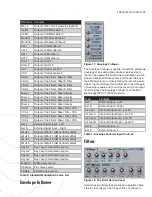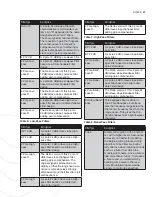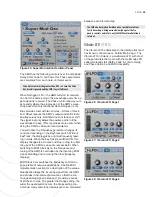
FILTERS |
21
Filter Type
Description
Retro LP
A 4-pole, 24 dB slope
fi
lter with
characteristics of old modular sys-
tems. An “R” appended to the name
designates other “retro”
fi
lters.
These are typically resonant
fi
lters.
The reduction in gain that happens
when resonance is increased is
compensated for, so that the input
signal level appears to remain con-
stant, due to gain compensation.
LP 12 dB
A 2 pole 12 dB/slope Lowpass
fi
lter
2 Pole Low-
pass
A 2 pole 12 dB/slope Lowpass
fi
lter
based on a State Variable Filter
design
2 Pole Low-
pass R
The Retro version of this 2 pole
12 dB/octave slope Lowpass
fi
lter,
adding gain compensation
4 Pole Low-
pass
A 4 pole 24 dB/slope Lowpass
fi
lter
based on a State Variable Filter
design
4 Pole Low-
pass R
The Retro version of this 4 pole
24 dB/octave slope Lowpass
fi
lter,
adding gain compensation
6 Pole Low-
pass
A 6 pole 36 dB/octave slope Low-
pass
fi
lter based on a State Variable
Filter design
6 Pole Low-
pass R
The Retro version of this 6 pole
36 dB/octave slope Lowpass
fi
lter,
adding gain compensation
Low-Pass
Table 6:
Filters
Filter Type
Description
HP 12 dB
A 2 pole 12 dB/octave slope High-
pass
fi
lter
HP 24 dB
A 4 pole 24 dB/ octave slope High-
pass
fi
lter
2 Pole High-
pass
A 2 pole 12 dB/ octave slope High-
pass
fi
lter based on a State Vari-
able Filter design
2 Pole High-
pass R
The Retro version of this 2 pole 12
dB/octave slope Highpass
fi
lter,
adding gain compensation. The
original signal is attenuated only
slightly, so that the range near reso-
nance is somewhat less strongly
emphasized, and the
fi
lter offers full
self-resonance.
4 Pole High-
pass
A 4 pole 24 dB/ octave slope High-
pass
fi
lter based on a State Vari-
able Filter design
Filter Type
Description
4 Pole High-
pass R
The Retro version of this 4 pole 24
dB/octave slope Highpass
fi
lter,
adding gain compensation
High-Pass
Table 7:
Filters
Filter Type
Description
BP 12 dB
A 2 pole 12 dB/ octave slope Band-
pass
fi
lter
BP 24 dB
A 4 pole 24 dB/ octave slope Band-
pass
fi
lter
2 Pole Band-
pass
A 2 pole 12 dB/ octave slope Band-
pass
fi
lter based on a State Vari-
able Filter design
2 Pole Band-
pass R
The Retro version of this 2 pole 12
dB/octave slope Bandpass
fi
lter,
adding gain compensation
4 Pole Band-
pass
A 4 pole 24 dB/ octave slope Band-
pass
fi
lter based on a State Vari-
able Filter design
4 Pole Band-
pass R
The Retro version of this 4 pole 24
dB/octave slope Bandpass
fi
lter,
adding gain compensation
Contrary Band-
pass
This bandpass
fi
lter is similar to
the 2-Pole Bandpass, but attenu-
ates the frequency range below the
fi
lter center frequency less than the
range above. This gives the Con-
trary Bandpass
fi
lter a light lowpass
character.
Band-Pass
Table 8:
Filters
Filter Type
Description
Tube
Similar construction to the Comb
fi
l-
ter, with a higher level of resonance
achieved, and better for modeling
the Karplus-Strong ‘plucked string’
algorithm. Tube
fi
lters are particu-
larly effective when imitating sounds
such as a
fl
ute (from which the
module got its name, since a
fl
ute is
little more than a ‘tube’). To produce
a
fl
ute sound, you would start by
sending some noise to the reso-
nator. Modulation inputs provide
signals to control the spectrum.
















































